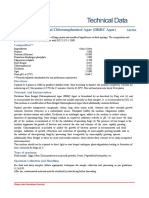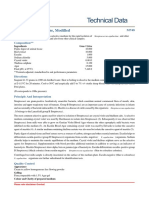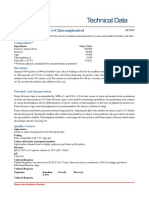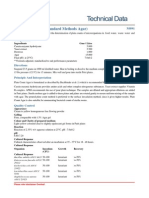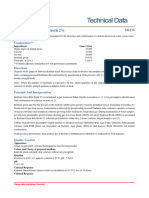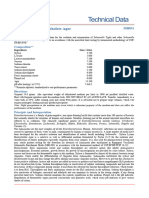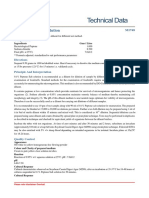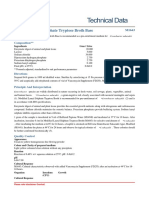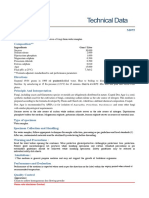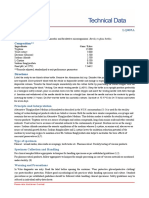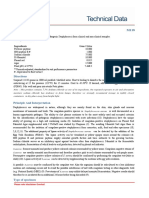™ Ec O157:H7 Agar, Modified: Hicrome
™ Ec O157:H7 Agar, Modified: Hicrome
Uploaded by
diana benites salcedoCopyright:
Available Formats
™ Ec O157:H7 Agar, Modified: Hicrome
™ Ec O157:H7 Agar, Modified: Hicrome
Uploaded by
diana benites salcedoOriginal Title
Copyright
Available Formats
Share this document
Did you find this document useful?
Is this content inappropriate?
Copyright:
Available Formats
™ Ec O157:H7 Agar, Modified: Hicrome
™ Ec O157:H7 Agar, Modified: Hicrome
Uploaded by
diana benites salcedoCopyright:
Available Formats
HiCrome™ EC O157:H7 Agar,Modified M1574A
Intended Use
Recommended for isolation and differentiation of Escherichia coli O157:H7 from food and environmental samples.
Composition**
Ingredients Gms / Litre
Tryptone 8.000
Sorbitol 7.000
Bile salts mixture 1.500
Sodium lauryl sulphate 0.100
Chromogenic mixture 0.250
Agar 12.000
Final pH ( at 25°C) 6.8±0.2
**Formula adjusted, standardized to suit performance parameters
Directions
Suspend 28.85 grams in 1000 ml distilled water. Heat to boiling to dissolve the medium completely. Sterilize by autoclaving at
15 lbs pressure (121°C) for 15 minutes. Cool to 45- 50°C. Mix well and pour into sterile Petri plates. This medium can be made
more selective by aseptically adding 0.25 ml of rehydrated contents of one vial of FD052 (1% Potassium Tellurite Solution)
to 1000 ml molten and cooled medium (45-50°C).
Principle And Interpretation
Escherichia coli O157:H7 belongs to the Enterohemorrhagic Escherichia coli (EHEC) group and it predominates as a
food borne pathogen. E.coli O157: H7 was first recognized as a human pathogen in 1982 when two outbreaks of hemorrhagic
colitis were associated with consumption of undercooked ground beef that has been contaminated with this organism (1).
HiCrome™ EC O157:H7 Agar is a chromogenic medium recommended for the isolation and differentiation of E.coli
O157:H7 from food and environmental samples. HiCrome™ EC O157:H7 Agar is based on the formulation described by
Rappaport and Henigh (2). The medium contains sorbitolas a fermentable carbohydrate and a chromogenic mixture instead
of lactose and indicator dyes respectively. The chromogenic substrate is specifically and selectively cleaved by
Escherichia coli O157: H7 resulting in a dark purple to magenta coloured moiety. E.coli give bluish green coloured
colonies.
Tryptone provides carbonaceous, nitrogenous and growth nutrients. Sodium chloride maintains osmotic
equilibrium.Bilesalts mixture and Sodium lauryl sulphate inhibits gram-positive organisms. Potassium tellurite selects the
serogroups and inhibits Aeromonas species and Providencia species.
Type of specimen
Food
Specimen Collection and Handling:
For food samples, follow appropriate techniques for sample collection and processing as per guidelines (3).
Warning and Precautions:
In Vitro diagnostic Use only. Read the label before opening the container. Wear protective gloves/protective clothing/
eyeprotection/ face protection. Follow good microbiological lab practices while handling specimens and culture.
Standard precautions as per established guidleines should be followed while handling clincal specimens. Saftey
guidelines may be referred in individual safety data sheets
Limitations :
Due to variable nutritional requirements, some strains show poor growth on this medium.
Please refer disclaimer Overleaf.
HiMedia Laboratories Technical Data
Performance and Evaluation
Performance of the medium is expected when used as per the direction on the label within the expiry period when stored at
recommended temperature.
Quality Control
Appearance
Cream to yellow homogeneous free flowing powder
Gelling
Firm, comparable with 1.2% Agar gel.
Colour and Clarity of prepared medium
Light amber coloured, clear to slightly opalescent gel forms in Petri plates
Reaction
Reaction of 2.88% w/v aqeuous solution at 25°C. pH : 6.8±0.2
pH
6.60-7.00
Cultural Response
Cultural characteristics observed after an incubation at 35-37°C for 18- 24 hours.
Organism Inoculum Growth Recovery Colour of
(CFU) Colony
Bacillus subtilis ATCC 6633 >=10³ inhibited 0%
(00003*)
Escherichia coli O157:H7 50-100 luxuriant >=50% dark purple-
(NCTC 12900) magenta
Escherichia coli ATCC 50-100 luxuriant >=50% bluish green
25922 (00013*)
Klebsiella pneumoniae 50-100 luxuriant >=50% colourless-mauve, mucoid
ATCC 13883
Pseudomonas aeruginosa 50-100 luxuriant >=50% colourless
ATCC 27853 (00025*)
Staphylococcus aureus >=10³ inhibited 0%
ATCC 25923 (00034*)
Key : *Corresponding WDCM numbers.
Storage and Shelf Life
Store dehydrated powder and the prepared medium at 2-8º C in tightly closed container . Use before expiry date on the
label. On opening, product should be properly stored dry, after tightly capping the bottle inorder to prevent lump
formation due to the hygroscopic nature of the product. Improper storage of the product may lead to lump formation.
Store in dry ventilated area protected from extremes of temperature and sources of ignition Seal the container tightly
after use. Use before expiry date on the label.
Product performance is best if used within stated expiry period.
Disposal
User must ensure safe disposal by autoclaving and/or incineration of used or unusable preparations of this product. Follow
established laboratory procedures in disposing of infectious materials and material that comes into contact with clinical
sample must be decontaminated and disposed of in accordance with current laboratory techniques (4,5).
Reference
1.Downes F. P. and Ito K., (Ed.), 2001, Compendium of Methods for the Microbiological Examination of Foods, 4th Ed.,
American Public Health Association, Washington, D.C.
2.Rappaport F. and Henigh E., 1952, J. Clin. Pathol., 5:361.
Please refer disclaimer Overleaf.
HiMedia Laboratories Technical Data
3. Downes F. P. and Ito K., (Ed.), 2001, Compendium of Methods for the Microbiological Examination of Foods, 4th Ed.,
American Public Health Association, Washington, D.C.
4.Isenberg, H.D. Clinical Microbiology Procedures Handbook. 2nd Edition.
5. Jorgensen,J.H., Pfaller , M.A., Carroll, K.C., Funke, G., Landry, M.L., Richter, S.S and Warnock., D.W. (2015)
Manual of Clinical Microbiology, 11th Edition. Vol. 1.
Revision : 01 / 2017
Disclaimer :
User must ensure suitability of the product(s) in their application prior to use. Products conform solely to the information contained in
this and other related HiMedia™ publications. The information contained in this publication is based on our research and development
work and is to the best of our knowledge true and accurate. HiMedia™ Laboratories Pvt Ltd reserves the right to make changes to
specifications and information related to the products at any time. Products are not intended for human or animal or therapeutic use but
for laboratory,diagnostic, research or further manufacturing use only, unless otherwise specified. Statements contained herein should not
be considered as a warranty of any kind, expressed or implied, and no liability is accepted for infringement of any patents.
HiMedia Laboratories Pvt. Ltd. A-516,Swastik Disha Business Park,Via Vadhani Ind. Est., LBS Marg, Mumbai-400086, India. Customer care No.: 022-6147
1919 Email: techhelp@himedialabs.com Website: www.himedialabs.com
You might also like
- Hera Strategy Guide 2024 02Document20 pagesHera Strategy Guide 2024 02Le CuackNo ratings yet
- Past Year Q For Wireman 1Document18 pagesPast Year Q For Wireman 1陈系铭100% (1)
- Cables Passing Through or Over Joists: BS 7671: 2008 Requires A Cable Installed Under A Floor or Above ADocument2 pagesCables Passing Through or Over Joists: BS 7671: 2008 Requires A Cable Installed Under A Floor or Above AMyoZawNo ratings yet
- Etihad RailDocument8 pagesEtihad RailMuhammad AbidNo ratings yet
- Car Wash BusinessDocument19 pagesCar Wash BusinessPeter Mboma100% (2)
- Hicrome™ Ecc Selective Agar Base: Intended Use: CompositionDocument3 pagesHicrome™ Ecc Selective Agar Base: Intended Use: Compositionafiifa1015No ratings yet
- M008SDocument3 pagesM008Sanulorance98No ratings yet
- Buffered Peptone Water: Intended UseDocument3 pagesBuffered Peptone Water: Intended UseUlliaNo ratings yet
- MM242Document3 pagesMM242Anand H SNo ratings yet
- Chloran Rose Bengal Chloramphenicol Agar (DRBC Agar) : Intended UseDocument3 pagesChloran Rose Bengal Chloramphenicol Agar (DRBC Agar) : Intended Useபொ.தெய்வராஜன்No ratings yet
- M001 PDFDocument3 pagesM001 PDFkeresahanmuNo ratings yet
- MH581Document3 pagesMH581Abid Iqbal ARDNo ratings yet
- Plate Count Agar (Standard Methods Agar) : Intended UseDocument3 pagesPlate Count Agar (Standard Methods Agar) : Intended UsenuraenirianNo ratings yet
- Urea Broth Base (Diagnostic Stuarts Urea Broth Base) : Intended UseDocument3 pagesUrea Broth Base (Diagnostic Stuarts Urea Broth Base) : Intended Use10605114No ratings yet
- Agar EdwardsDocument2 pagesAgar EdwardsGeraldine CacaceNo ratings yet
- PDA With ChlorampenicolDocument2 pagesPDA With ChlorampenicolIrene Ratri Andia SasmitaNo ratings yet
- Plate Count Agar (Standard Methods Agar) : CompositionDocument2 pagesPlate Count Agar (Standard Methods Agar) : CompositionAgitha KhariesmaNo ratings yet
- Technical Data: Plate Count Agar (Standard Methods Agar)Document2 pagesTechnical Data: Plate Count Agar (Standard Methods Agar)பொ.தெய்வராஜன்No ratings yet
- Peptone Water: Intended Use: CompositionDocument3 pagesPeptone Water: Intended Use: Composition10605114No ratings yet
- EMB Agar: Composition Intended UseDocument3 pagesEMB Agar: Composition Intended UseAbdulrahmanNo ratings yet
- BETA-SSA Agar (Group A Streptococci Selective Agar)Document3 pagesBETA-SSA Agar (Group A Streptococci Selective Agar)uttam.micro404No ratings yet
- PCAM091Document2 pagesPCAM091HariNo ratings yet
- Nutrient BrothDocument2 pagesNutrient BrothDip MajumderNo ratings yet
- M121IDocument2 pagesM121IventyfaniaNo ratings yet
- M121SDocument2 pagesM121SventyfaniaNo ratings yet
- Buffered Peptone Water, GranulatedDocument3 pagesBuffered Peptone Water, GranulateduttamNo ratings yet
- Nutrient Agar 2Document3 pagesNutrient Agar 2Khaza VinodNo ratings yet
- Blood Agar Base (Infusion Agar) : Intended UseDocument3 pagesBlood Agar Base (Infusion Agar) : Intended UseJohnree A. EvangelistaNo ratings yet
- Violet Red Bile Agar: CompositionDocument2 pagesViolet Red Bile Agar: CompositionMuhammad AdnanNo ratings yet
- Malt Extract Agar: Intended UseDocument3 pagesMalt Extract Agar: Intended UseMimma MonicaNo ratings yet
- Sabouraud Dextrose Broth (Sabouraud Liquid Medium) : Intended UseDocument3 pagesSabouraud Dextrose Broth (Sabouraud Liquid Medium) : Intended UseCintya Arum SariNo ratings yet
- MH031 Xylose-Lysine-Deoxycholate Agar, HarmonizedDocument4 pagesMH031 Xylose-Lysine-Deoxycholate Agar, Harmonizedtogapn470No ratings yet
- M031IDocument3 pagesM031Idarrendelfinoy9No ratings yet
- Clostridial Agar: Intended UseDocument3 pagesClostridial Agar: Intended Usesg.comNo ratings yet
- M1076Document2 pagesM1076Aarde StanovnikNo ratings yet
- Mannitol Salt Agar: Intended UseDocument4 pagesMannitol Salt Agar: Intended UseoktaNo ratings yet
- Gifu Anaerobic Broth (GAM) : Intended UseDocument3 pagesGifu Anaerobic Broth (GAM) : Intended UseVishwanath Unique BiotechNo ratings yet
- Yeast Extrac AgarDocument2 pagesYeast Extrac AgarMegawati KusumaNo ratings yet
- Mitis Salivarius Agar Base: CompositionDocument2 pagesMitis Salivarius Agar Base: CompositionAbid SiddiquiNo ratings yet
- Lactobacillus Leichmannii Vitamina b12Document2 pagesLactobacillus Leichmannii Vitamina b12Santiago RochaNo ratings yet
- M1297ADocument3 pagesM1297Ateena jacobNo ratings yet
- TechnicalDocument2 pagesTechnicalnafiw31466No ratings yet
- Technical Data: Peptone WaterDocument3 pagesTechnical Data: Peptone WaterAbdulrahmanNo ratings yet
- 0.1% Peptone Salt Solution: CompositionDocument2 pages0.1% Peptone Salt Solution: CompositionAmir Irshad BanjonsaNo ratings yet
- Pseudomonas Agar (For Pyocyanin) (In A Accordance With IP 2007)Document2 pagesPseudomonas Agar (For Pyocyanin) (In A Accordance With IP 2007)sezinaltiokkNo ratings yet
- Rose BengalDocument3 pagesRose BengalKhaza VinodNo ratings yet
- Technical Data: Enriched Thioglycollate BrothDocument3 pagesTechnical Data: Enriched Thioglycollate Brothபொ.தெய்வராஜன்No ratings yet
- TDS MH443Document3 pagesTDS MH443florengrace.fg98No ratings yet
- M1991IDocument3 pagesM1991IWindi LestariNo ratings yet
- M1990IDocument2 pagesM1990IDr. Shantanu KodapeNo ratings yet
- M1643 LSTB MediumDocument2 pagesM1643 LSTB Mediumayuningtyas wahyuNo ratings yet
- Czapek Dox Agar: Intended UseDocument2 pagesCzapek Dox Agar: Intended Useo8o0o_o0o8o2533No ratings yet
- Dey-Engley Neutralizing BrothDocument2 pagesDey-Engley Neutralizing BrothAnonymous WxIzg7tNo ratings yet
- Tryptic Soya Agar: Intended UseDocument2 pagesTryptic Soya Agar: Intended UseGopi NathNo ratings yet
- LQ007ADocument3 pagesLQ007Aபொ.தெய்வராஜன்No ratings yet
- Pseudomonas Isolation HiCynth™ Agar BaseDocument2 pagesPseudomonas Isolation HiCynth™ Agar Baseuttam.micro404No ratings yet
- Msa PDFDocument4 pagesMsa PDFARATHY M NAIR 2147718No ratings yet
- Lysine Decarboxylase PDFDocument3 pagesLysine Decarboxylase PDFSherly MardianaNo ratings yet
- LQ181VDocument3 pagesLQ181Vsatyen.ghosh1111No ratings yet
- Sabouraud Cycloheximide Chloramphenicol Agar: Intended UseDocument3 pagesSabouraud Cycloheximide Chloramphenicol Agar: Intended UsenadyasantikaNo ratings yet
- Methyl Red Indicator: Intended Use: CompositionDocument2 pagesMethyl Red Indicator: Intended Use: CompositionAli HamzaNo ratings yet
- MH144 SJSMSNDocument3 pagesMH144 SJSMSNsulistyani sapardiNo ratings yet
- Himedia M933Document3 pagesHimedia M933linaNo ratings yet
- Diluting Fluid A: Intended UseDocument2 pagesDiluting Fluid A: Intended UseCarina Munir SayidiNo ratings yet
- VM898228 990000704872 MP enDocument1 pageVM898228 990000704872 MP endiana benites salcedoNo ratings yet
- 10800bc Ug4655en MKDocument2 pages10800bc Ug4655en MKdiana benites salcedoNo ratings yet
- Usp 41 PDF InglesDocument8 pagesUsp 41 PDF Inglesdiana benites salcedoNo ratings yet
- Potassium Dihydrogen Ortho Phosphate CAS No 7778-77-0: Material Safety Data Sheet Sds/MsdsDocument6 pagesPotassium Dihydrogen Ortho Phosphate CAS No 7778-77-0: Material Safety Data Sheet Sds/Msdsdiana benites salcedoNo ratings yet
- Functional Biology NOTESDocument113 pagesFunctional Biology NOTESRebecca Amy JennerNo ratings yet
- Shelf Life Extension of CheeseDocument18 pagesShelf Life Extension of Cheesenils2484100% (1)
- DOUBLE SKIN FACADES FOR OFFICE BUILDINGS IN HOT AND DRY FinalDocument63 pagesDOUBLE SKIN FACADES FOR OFFICE BUILDINGS IN HOT AND DRY FinalharishNo ratings yet
- Clean Beauty Simple and SafeDocument12 pagesClean Beauty Simple and SafeRada PjanovicNo ratings yet
- General SpecificationDocument327 pagesGeneral SpecificationmaymanyassinNo ratings yet
- Permanent Magnet Synchronous Motor (PMSM) DesignDocument47 pagesPermanent Magnet Synchronous Motor (PMSM) DesignRAMESH P (PC2013005013009)100% (1)
- Q1. Comprehension: (5marks) Read The Passage Carefully Then Answer The Questions Given at The EndDocument5 pagesQ1. Comprehension: (5marks) Read The Passage Carefully Then Answer The Questions Given at The EndSana AliNo ratings yet
- Secret Language of AttractionDocument288 pagesSecret Language of AttractiontrongkienckvNo ratings yet
- NR600 ParametersDocument26 pagesNR600 ParametersMohit Pal100% (1)
- Taylor's Theorem - WikipediaDocument13 pagesTaylor's Theorem - WikipediaJasonNo ratings yet
- 4x Plant Tissue Culture Media & ChemicalsDocument14 pages4x Plant Tissue Culture Media & Chemicalsxxx_pic2531No ratings yet
- Mathematical Association of America, Taylor & Francis, Ltd. Mathematics MagazineDocument6 pagesMathematical Association of America, Taylor & Francis, Ltd. Mathematics Magazineenota15No ratings yet
- MSC - Marc and MSC - Marc Mentat: Release GuideDocument112 pagesMSC - Marc and MSC - Marc Mentat: Release GuideMahmud Kori EffendiNo ratings yet
- ETHICS 2022 Ethics Is The Branch of Philosophy That Studies Morality or The Rightness or Wrongness of HumanDocument20 pagesETHICS 2022 Ethics Is The Branch of Philosophy That Studies Morality or The Rightness or Wrongness of HumanJustin LapasandaNo ratings yet
- BU406Document5 pagesBU406Ahmed ZagharyNo ratings yet
- From Hand To MouthDocument8 pagesFrom Hand To MouthAbigail MirabelNo ratings yet
- Tamil Nadu 11th Standard HistoryDocument138 pagesTamil Nadu 11th Standard HistoryIndia History Resources100% (5)
- Check List For Iso and ValvesDocument13 pagesCheck List For Iso and ValvesNeeraj JanakiramanNo ratings yet
- Postnatal Assessment ProcedureDocument4 pagesPostnatal Assessment ProcedureApex College of Nursing100% (2)
- TUGAS Catalysts and Catalysis by AHMAD BERLIAN NIM 94221003Document7 pagesTUGAS Catalysts and Catalysis by AHMAD BERLIAN NIM 94221003Onggy Aries SekaNo ratings yet
- Seven Chakra ChartDocument1 pageSeven Chakra ChartPRaoNo ratings yet
- Module 6 System Operation Version CDocument97 pagesModule 6 System Operation Version CVipinraj KrishnanNo ratings yet
- NABH QuestionnairDocument3 pagesNABH QuestionnairRicha100% (4)
- Chloride Ion Migration/diffusion Through Concrete and Test MethodsDocument30 pagesChloride Ion Migration/diffusion Through Concrete and Test Methodsrekcah ehtNo ratings yet









